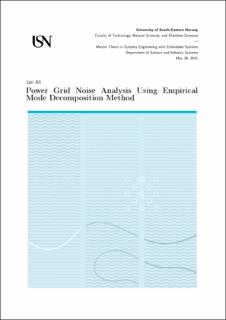Power Grid Noise Analysis Using Empirical Mode Decomposition Method
Master thesis
Permanent lenke
https://hdl.handle.net/11250/2992977Utgivelsesdato
2021Metadata
Vis full innførselSamlinger
Sammendrag
Due to the increasing consumption of electrical load and growth in the use of sensitive devices connected
to power grid, Power quality (PQ) has become a subject of interest. PQ disturbances (PQDs) that
affect voltage or current in the power system, may introduce some technical problems; hence, detection
and mitigation of these PQDs are necessary. Recently, several techniques and methods for PQ analysis
have been developed. Since most of the PQ events are non- stationary, proper time-frequency analysis
techniques are required that can accurately identify and analyze events and disturbance in the power
system. One of the recently developed tools that can be used for decomposition and analysis of any
complex signal, is the Empirical Mode Decomposition (EMD) method. It is an adaptive time-frequency
method for analyzing transient, nonlinear, and non-stationary signals.
In this thesis the EMD, Short Time Fourier Transform (STFT) and Continuous Wavelet Transform
(CWT) are studied and applied to analyze a PQ event related to single phase low voltage power grid.
Then their effectiveness and performance are evaluated. The STFT can provide the time–frequency
domain information, but a compromise between time and frequency resolution has to be established
because it is using a fixed window. To overcome this shortcoming, the CWT is used which utilizes
variable sized windowing technique in order to maintain time and frequency resolution simultaneously.
The WT yields high frequency resolution but low time resolution in the low frequency components,
while low frequency resolution but high time resolution in the high frequency components. It needs to
select a certain wavelet as primary function. Moreover, it encounters difficultly in noisy conditions.
The EMD decomposes the signal into a sum of intrinsic oscillatory components, known as Intrinsic
Mode Functions (IMFs). Each IMF has different frequency components, which are extracted through
sifting processes in a way from the highest frequency to the lowest. Once the IMFs are obtained, the
Hilbert Transform (HT) can then be applied to calculate the instantaneous frequency and amplitude of
each IMF. The combination of the EMD and the HT is known as the Hilbert–Huang Transform (HHT).
The EMD is a fully data-driven signal analysis method which does not need any a priori defined basis
function. The empirical nature of EMD presents the advantage over other signal analysis methods.
Although EMD has demonstrated to be an effective method for analyzing non-stationary signals, it
experiences some shortcomings. Mode mixing is one of the major problem to the EMD method. In
order to overcome the mode mixing issue, a noise-assisted data analysis method referred to as the
Ensemble EMD (EEMD) is implemented. The added white noise will be averaged out with sufficient
number of trials; the only persistent part that survives the averaging process is the component of the
original signal.
